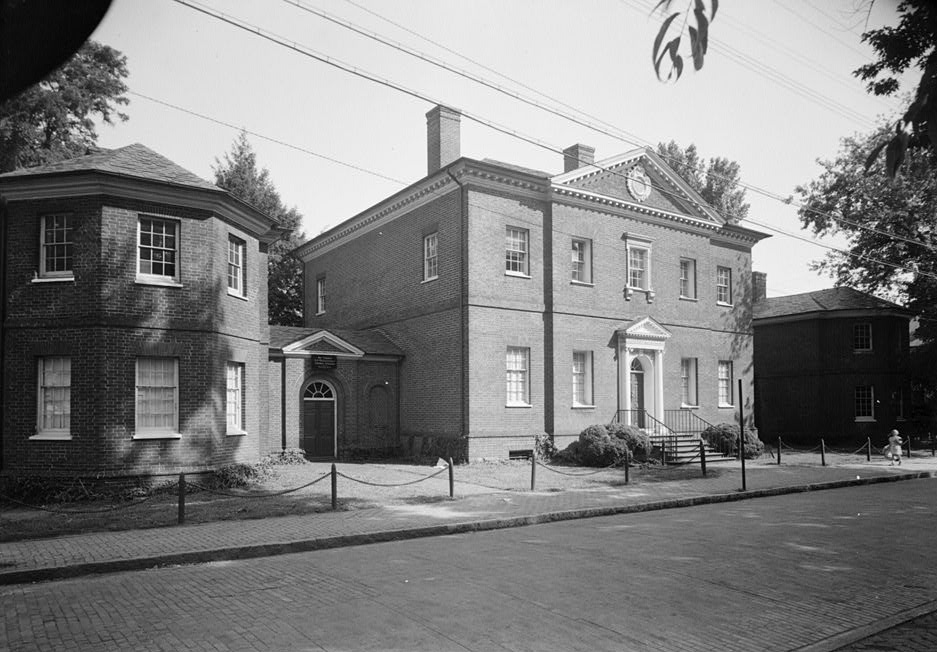- Hammond-Harwood House
Infobox_nrhp | name =Hammond-Harwood House
nrhp_type = nhl

caption = Exterior view of the Hammond-Harwood House
location=Annapolis, Maryland
lat_degrees = 38
lat_minutes = 58
lat_seconds = 51
lat_direction = N
long_degrees = 76
long_minutes = 29
long_seconds = 19
long_direction = W
locmapin = Maryland
area =
built =1773
architect= Buckland,William
architecture= Georgian
added =October 15 ,1966
governing_body = Private
refnum=66000384cite web|url=http://www.nr.nps.gov/|title=National Register Information System|date=2007-01-23|work=National Register of Historic Places|publisher=National Park Service]The Hammond-Harwood House in
Annapolis, Maryland , U.S.A. is one of the premiercolonial house s remaining in America from theBritish colonial period (1607-1776). It is the only existing work of colonial academic architecture that was principally designed from a plate inAndrea Palladio ’s, "I quattro libri dell’architettura", 1570, (The Four Books of Architecture). The house was designed by the architect, William Buckland in 1773-74 for wealthyfarmer Matthias Hammond ofAnne Arundel County ,Maryland . It was modeled on the design of the Villa Pisani inMontagnana ,Italy in Book II, Chapter XIV of "I quattro libri dell’architettura."History
Construction on the house began in, or around, April 1774 and a majority of the house was probably completed before the death of the architect in November or December of the same year. The patron Matthias Hammond probably never occupied his elegant house because he abruptly left Annapolis for his family's country estate in 1776. He died in 1786 after renting the house for many years.
The house passed to his nephews John and then Philip Hammond who eventually sold the house to Ninian Pinkney in 1810. Pinkney, however quickly sold the house to Judge Jeremiah Townley Chase in 1811. Judge Chase bought the house as a home for the family of his daughter Frances Townley Chase Loockerman. He was well acquainted with the house because he rented the northeast wing beginning in the late 1770s.
Judge Chase’s descendants lived in the house until the death of his great-granddaughter Hester Ann Harwood in 1924. Judge Chase’s granddaughter married William Harwood, the great-grandson of William Buckland the architect of the house.
Hester Ann Harwood died intestate and the house was sold in 1926 to St. John’s College. The College used the house as a teaching tool for one of America’s first courses taught on the
decorative arts until financial necessity forced the college to sell to the Hammond-Harwood House Association in 1940. This non-profit corporation continues to own the house and uses it as a museum that is open to the public .Architecture
The house ranks architecturally with many of the great mansions built in the late Colonial period; however, it is the only house directly inspired from a plate in Palladio’s, "I quattro libri dell’architettura". It is arguably the most exquisite house remaining from the Colonial period in America.
Architect William Buckland cleverly adapted Palladio's Villa Pisani design to satisfy the tastes of colonial Annapolis. He re-designed the plan to accommodate the tastes for asymmetrical regional preferences and modified the hyphens from Palladio's arched entries to more practical single storey connecting links. He also incorporated fashionable urban design by sinking the windows in the method mandated by the London Building Act of 1709. This device provided better protection from fire and gave the overall design a greater degree of visual solidity and three dimensionality (see image at right). This adaptation from Palladio's model marks his maturity as an architect and ranks him as one of America's first and finest architects.
The initial design of
Thomas Jefferson ’sMonticello was taken from the Villa Cornaro inPiombino Dese ,Italy , in Book II, Chapter XV of "I quattro libri dell’architettura", but this façade was later covered up by Jefferson’s own expansions to his house. Thomas Jefferson made two drawings of the Hammond-Harwood House when he served the government in Annapolis in 1783-4. One could assume that Jefferson recognized the house as derived from Palladio because his knowledge of "The Four Books of Architecture" was extensive. He referred to the book as his architectural “bible” and the plate of the Villa Cornaro follows the Villa Pisani plate; and directly opposite the Villa Cornaro in some 18th century English transcriptions of the work.The Hammond-Harwood House was featured in
Bob Vila 'sA&E Network production, "Guide to Historic Homes of America,"cite web |url= http://www.bobvila.com/BVTV/AE/America.html |title= "Guide to Historic Homes of America." |author=Bob Vila |format=html |work=A&E Network |date= 1996 |quote= ] in the two-hour segment on theMid-Atlantic States .cite web |url= http://www.bobvila.com/BVTV/AE/Atlantic.html |title= "Bob Vila's Guide to Historic Homes of the Mid-Atlantic." |format=html |work=A&E Network |quote= ]ee also
*
Paca House and Garden
*Brice House References
External links
* [http://www.hammondharwoodhouse.org hammondharwoodhouse.org] Official web site
* [http://www.marylandhistoricaltrust.net/nr/NRDetail.aspx?HDID=3&FROM=NRNHLList.aspx Hammond-Harwood House, Anne Arundel County] , including undated photo, at Maryland Historical Trust
* [http://hdl.loc.gov/loc.pnp/hhh.md0035 Hammond-Harwood House, 19 Maryland Avenue & King George Street, Annapolis, Anne Arundel County, MD: 17 drawings, 16 photos, 2 data pages, 1 color transparency] , atHistoric American Building Survey
Wikimedia Foundation. 2010.
